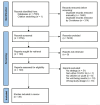Well-being approaches targeted to improve child and youth health post-COVID-19 pandemic: a scoping review
- PMID: 38907284
- PMCID: PMC11193255
- DOI: 10.1186/s12913-024-11140-7
Well-being approaches targeted to improve child and youth health post-COVID-19 pandemic: a scoping review
Abstract
Background: Our previous work synthesized published studies on well-being interventions during COVID-19. As we move into a post-COVID-19 pandemic period there is a need to comprehensively review published strategies, approaches, and interventions to improve child and youth well-being beyond deleterious impacts experienced during COVID-19.
Methods: Seven databases were searched from inception to January 2023. Studies were included if they: (1) presented original data on an approach (i.e., approach applied) or (2) provided recommendations to inform development of a future approach (i.e., approach suggested), (3) targeted to mitigate negative impacts of COVID-19 on child and youth (≤18 year) well-being, and (4) published on or after December 2019.
Results: 39 studies (n = 4/39, 10.3% randomized controlled trials) from 2021 to 2023 were included. Twenty-two studies applied an approach (n = 22/39, 56.4%) whereas seventeen studies (n = 17/39, 43.6%) suggested an approach; youth aged 13-18 year (n = 27/39, 69.2%) were most frequently studied. Approach applied records most frequently adopted an experimental design (n = 11/22, 50.0%), whereas approach suggested records most frequently adopted a cross-sectional design (n = 13/22, 59.1%). The most frequently reported outcomes related to good health and optimum nutrition (n = 28/39, 71.8%), followed by connectedness (n = 22/39, 56.4%), learning, competence, education, skills, and employability (n = 18/39, 46.1%), and agency and resilience (n = 16/39, 41.0%).
Conclusions: The rapid onset and unpredictability of COVID-19 precluded meaningful engagement of children and youth in strategy development despite widespread recognition that early engagement can enhance usefulness and acceptability of interventions. Published or recommended strategies were most frequently targeted to improve connectedness, belonging, and socialization among children and youth.
Keywords: COVID-19; Children; Scoping review; Well-being; Youth.
© 2024. The Author(s).
Conflict of interest statement
The authors declare no competing interests.
References
-
- Coller RJ, Webber S. COVID-19 and the Well-being of children and families. Pediatrics 2020, 146(4). - PubMed
-
- Patrick SW, Henkhaus LE, Zickafoose JS, Lovell K, Halvorson A, Loch S, Letterie M, Davis MM. Well-being of parents and children during the COVID-19 pandemic: a national survey. Pediatrics 2020, 146(4). - PubMed
-
- Shonkoff JP, Garner AS, Child CoPAo, Family Health CoEC, Adoption, Dependent Care, Developmental So, Pediatrics B, Siegel BS, Dobbins MI, Earls MF et al: The lifelong effects of early childhood adversity and toxic stress. Pediatr. 2012; 129(1):e232–e246. - PubMed
Publication types
MeSH terms
LinkOut - more resources
Full Text Sources
Medical
Research Materials


